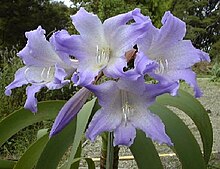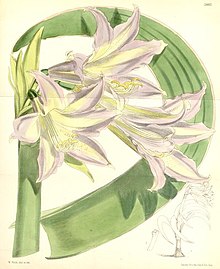| Worsleya | |
|---|---|

| |

| |
| Conservation status | |
 Critically Endangered (IUCN 3.1) | |
| Scientific classification | |
| Kingdom: | Plantae |
| Clade: | Tracheophytes |
| Clade: | Angiosperms |
| Clade: | Monocots |
| Order: | Asparagales |
| Family: | Amaryllidaceae |
| Subfamily: | Amaryllidoideae |
| Tribe: | Griffineae |
| Genus: | Worsleya (W.Watson ex Traub) Traub |
| Species: | W. procera |
| Binomial name | |
| Worsleya procera (Lem.) Traub | |
| Synonyms | |
| |
Worsleya is a genus of Brazilian plants in the amaryllis family Amaryllidaceae, cultivated as an ornamental because of its showy flowers. There is only one known species, Worsleya procera, native to eastern Brazil. It is endemic to the marshy top of a mesa called "Mount Cuca" 30 miles (52 km) north of Rio de Janeiro. Here the sickle-shaped leaves curve northward. When grown in the northern hemisphere, the leaves curve southward. It is one of the largest (around 1.5 meters (five feet) high by up to one foot (30 centimeters) thick near the base) and also rarest members of the subfamily Amaryllidoideae (family Amaryllidaceae).

This species is also known as the Empress of Brazil because of its origin in South America and in reference to the wife of Emperor Dom Pedro. It grows in very extreme and moist environments, and is commonly found near waterfalls in rich soil situated on granite rocks (which is why it is sometimes considered to be a lithophyte) and sunny places. However, it can be difficult to cultivate. It has plenty of needs, though it can exhibit great hardiness. It also has many ornamental traits.
Description

The plant has a large bulb that produces a high stem with green recurved leaves. Worsleya produces spectacular and beautiful blooms. They are large, lilac to blue, with small freckles on them. The seeds are black and semicircular, and (when cultivated) are usually sown in pumice or sometimes Sphagnum, although with Sphagnum the threat of decay is higher.
Conservation
It is critically endangered, and it is included in the Brazilian official list of endangered species.
Etymology
It is named after Arthington Worsley (1861-1943).
Cytology
The diploid chromosome count is 2n = 42 unlike its sister group Griffinia with 2n = 20.
References
- ^ Moraes, L. (2016). "Worsleya procera". IUCN Red List of Threatened Species. 2016: e.T107250165A107302241. Retrieved 26 October 2022.
- "Worsleya procera", World Checklist of Selected Plant Families, Royal Botanic Gardens, Kew, retrieved 2012-12-29
- The Plant List
- Kew World Checklist of Selected Plant Families
- Tropicos, Worsleya (W. Watson ex Traub) Traub
- Mabberley, David (May 3, 2002). "pbs New wiki photos Worsleya bloom". Retrieved 6 February 2011.
- Mabberley, David (1987). The plant-book. A portable dictionary of the higher plants. Cambridge University Press.
- Traub, Hamilton Paul 1944. Herbertia 10: 89
- Martinelli, Gustavo (1989). Campos de Altitude. <not stated>: Editora index. pp. 70–78.
- Everard, Barbara; Morley, Brian D. (1970). Wildflowers of the World. New York: G.P. Putnam and Sons. p. Plate 190 with caption.
- 1871 illustration from Hooker, Joseph Dalton. Curtis's Botanical Magazine, volume 97 Series 3, issue 27, plate 5883, as Amaryllis rayneri
- Lemaire, (Antoine) Charles. 1864. L'illustration horticole 11: t. 408. as Hippeastrum procerum .
- Duchartre, Pierre Étienne Simon. 1863. Bulletin de la Société Botanique de France 10: 75. as Amaryllis procera nom illeg., not Salisbury 1796.
- Traub, Hamilton Paul & Moldenke, Harold Norman. 1949. Amaryllis Manual 23. as Worsleya rayneri
- MEIRELLES, S. T., PIVELLO, V. R., & JOLY, C. A. (1999). The vegetation of granite rock outcrops in Rio de Janeiro, Brazil, and the need for its protection. Environmental Conservation, 26(1), 10–20. http://www.jstor.org/stable/44519516
- Empress of Brazil (Worsleya procera). (n.d.). Gardens by the Bay. Retrieved April 19, 2023, from https://www.gardensbythebay.com.sg/en/learn-with-us/explore-resources/whats-blooming/empress-of-brazil-worsleya-procera.html
- Dutilh, J. A. H. (2003, August). "Ornamental bulbous plants of Brazil." In V International Symposium on New Floricultural Crops 683 (pp. 37-42).
| Taxon identifiers | |
|---|---|
| Worsleya | |
| Worsleya rayneri | |
| Worsleya procera | |